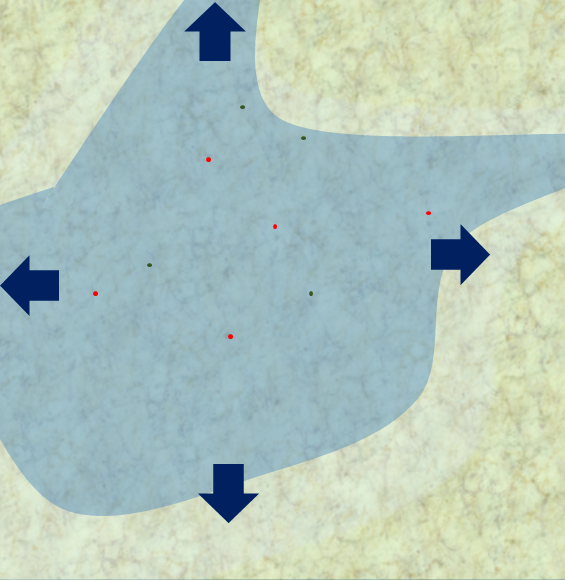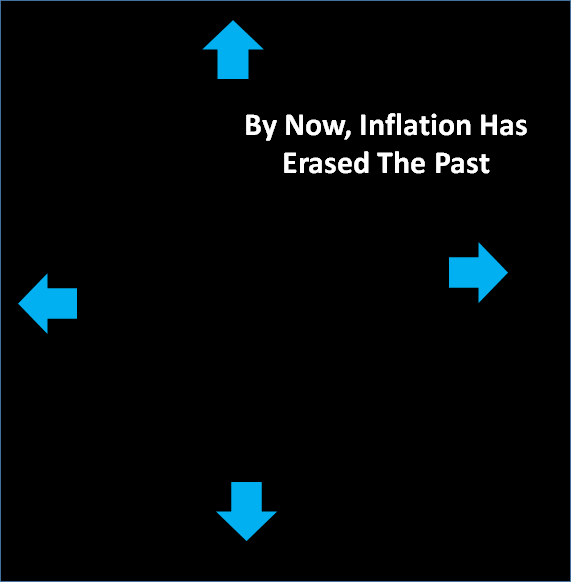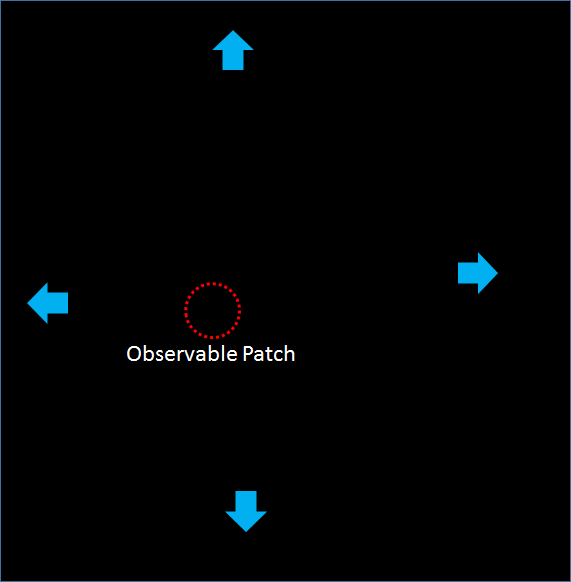Hot Big Bang and Inflation
- Transfer
Hot Big Bang
Hot Big Bang is a period of the Universe development, in the last stages of which we live with you. During this period, the observed part of the universe was initially dense and hot, and then it began to expand and cool. Expansion has slowed down until recently. Do not get confused: Hot Big Bang almost certainly began not at the earliest moments of the life of the Universe.
Some people call the Hot Big Bang (GBV) simply "Big Bang." Others, speaking of the Big Bang, imply an earlier time. Terminology issues will be described in the next article on inflation.
How hot was the GBV in the hottest state before starting to cool, and how did it start?
Surely we still do not know. GBV could begin when the Universe became hot at the end of the inflation period. In such a case, the HBV heat originated from the dark energy that fed the inflation, and the maximum temperature of the HBV depends on the amount of dark energy available.
The temperature could be:
- as large as a large percentage of the Planck temperature percentage (and then the Universe was so hot that it could create black holes simply due to the temperature), and
- as small as the temperature corresponding to the energy of the Large Hadron Collider (and then it would hardly have been enough to create Higgs particles).
And, probably, not below this mark.
Sometimes the maximum temperature of a HBV is referred to as the “reheat temperature”, but the word “repeated” can lead to confusion. People assumed that the Universe was hot both before and after inflation, hence the “reheat” - and you can find many sites, books, videos, images that demonstrate the same assumption - but it is not based on anything.
What happened next?
We are quite confident that we know the main milestones and many details of what happened over the next 13.7 billion years. The universe gradually expanded (the space grew larger), and cooled accordingly and became more empty. Compared with such an amazing event as inflation, the subsequent period was relatively boring, although there were quite important milestones along the way.
A few minutes after the onset of GBV:
- The Higgs field turned on (i.e., its average value became non-zero), which ensured that many of the particles that did not possess mass before, including quarks and electrons, occurring in ordinary matter, received a mass. Since then, the value of the Higgs field has remained constant, at least in the observable part of the Universe.
- Quarks, antiquarks and gluons, flying freely, combined and formed hadrons, including protons and neutrons.
- The first nuclei of atoms, different from hydrogen, were formed, as a result of which quite a lot of helium and some deuterium (heavy hydrogen), as well as lithium, appeared in the Universe. Later they became ingredients for the first stars.
380,000 years later, everything cooled down sufficiently to form the first atoms, and from that moment the Universe became for the most part a transparent place, the way we see it today. The light, which then was able to move freely throughout the universe, gives us "relic radiation."
About a hundred million years later, the first galaxies began to form and the first stars lit up. The exact time frame has not yet been established by measurements, but they are trying to do this.
We now live about 13.7 billion years after the onset of the GBV. Note that I did not write about the "age of the Universe", or that it began 13.7 billion years ago. We do not know for sure. We only know that the GBV began 13.7 billion years ago - but we do not know whether this moment was close to the beginning of the entire Universe.
Inflation
The epoch of inflation was probably a very short but certainly colorful period in which the space inside the part of the Universe, including our visible part (the one that we can observe today) was rapidly expanding at an absolutely incredible speed. The expansion rate was so big that it seems insane. And the only thing that keeps this idea from madness is that the theory of inflation produces predictions that so far are consistent with our measurements of the cosmos (including those that the BICEP2 project does ). This does not mean that it is correct, but it means that:
- there are good reasons for believing that she may be correct, and
- today no one can prove that it is wrong.
Once again: the space has expanded. Not matter torn into space: the space became much more. It was not at all like an explosion .
How insane was the speed of expansion? A part of the Universe the size of your computer screen has expanded to the size of a part of the Universe observed today, or even more, in less time than the quark needs to go from one side of the proton to the other. I will not even try to overwhelm you with numbers, partly because in fact we don’t know how long the inflation lasted, but also because the numbers mean too large sizes and too small periods of time that people could imagine them. In fact, a huge piece of the universe was created from a tiny piece almost instantly.
What was the universe like during this expansion? Empty. Extremely empty. Much, much, much more empty than space today. Very cold. Very dark. Everything that could be present in it before the onset of inflation was instantly broken off and carried away over great distances. Warning: there is quite an important and very subtle trick concerning statements about an empty / dark / cold Universe, and I still do not know how to describe it more accurately. It would be more accurate to say that the Universe was not just “extremely” empty, it was “as much as possible” empty, dark and cold — empty of everything except quantum fluctuations.
What happened before inflation and how it started was unknown to us. There are several reasonable theories based on science, but they will all be speculations until someone comes up with a way to test them with measurements. The “before inflation” period may not exist at all - either because inflation is constantly going somewhere in the Universe, or because time will not make sense if you go back far enough into the past, or for some other reason. But in many contexts it almost does not matter, as I will explain with images, answering some of the frequently asked questions along the way.
What caused the insane rate of inflation?
The reason was a large number of what is often called:
- “Dark energy” (but this is not energy, it is a certain combination of energy and negative pressure), or
- "Cosmological constant" ([not] Einstein's mistake; fortunately, this is not a constant, or the Universe would have experienced inflation forever), or
- “Dark smooth stretching” (which is true, but sounds clumsy and does not explain anything).
In general, there is a little of this substance in the Universe now, because of which the rate of expansion of the Universe has begun to increase over the past several billion years. But, we suspect that at some point for some reason it was much more. Because of what the area containing our part of the Universe, expanded at an incredible speed, that is, was subjected to "inflation." Figures 1, 2 and 3 contain unreasonable and probably incorrect guesses as to why inflation started, and in Fig. The four details of these conjectures no longer matter.

Fig. 1: a completely unreasonable conjecture about how a single section of the Universe could look like before the start of inflation. For some unknown reason, the gray area contains a huge amount of dark energy. Inside the gray area, I drew several objects marked with green and red dots. What is outside the gray region, I have no idea, but in the end it will not matter.
Where did this huge amount of dark energy come from?
We do not know. There are several assumptions, some of which were rejected by recent data. We hope to learn more on this topic in the next decade.

Fig. 2: dark energy causes the gray area to expand. Objects in the gray area (green and red dots) are spread to the sides with the expansion of space containing dark energy, which is becoming more voluminous, while not moving beyond the gray area.
Why does the expansion rate not slow down if the expansion dilutes dark energy?
It is strange and surprising that with the inflation of the Universe and the growth of its volume, the amount of dark energy in terms of unit volume remains constant. This means that inflation will go, and go, and go, without slowing down, until something causes the dark energy to disappear.

Fig. 3: Since dark energy, unlike conventional materials, does not become more rarefied as space expands, and its density remains constant, the gray area continues to expand. By this time, all the green and red dots, except for one, were out of sight. Whatever the temperature of the expanding section at the beginning, it becomes very cold (as cold as conditions allow).
Green and red dots move away from each other with great speed.
Does this incredible expansion mean that all things were moving apart from each other at a speed exceeding the speed of light, a universal speed limit?
Yes, that is right.
Does this not violate Einstein's theory of relativity?
No, it does not break. Einstein's theory says that if two objects pass by each other at one point in space, then for an observer moving with one of them, the measured speed of the other object will never exceed the speed of light. But two objects in two different places can move farther apart than the speed of light if space itself expands. That is what is happening in the expanding universe.

Fig. 4: The essence of the era of inflation. By this time, inflation has spread all the objects that existed in the gray area in Fig. 1 (red and green dots) for extremely long distances from each other. The gray area has expanded to an incredibly huge size, it has become terribly empty and cold. And the expansion can go on and on in several stages. The initial guesses shown in fig. 1 and fig. 2, are completely unrelated to the properties of this part of the universe; if we started a very good guess on fig. 1 and 2, we would still get the same pic. four.
I thought the Big Bang was associated with a very hot universe. And now you say she was very cold?
Yes, that is right. Well, almost like that. It is as cold as possible; however, the presence of quantum fluctuations introduces its own characteristics. The universe became hot after inflation (more on that later). Whether it was hot at some point before inflation, the question is purely speculative; There is still no evidence for or against. But during inflation, the temperature dropped to a small fraction of a degree above absolute zero.

Fig. 5: The expansion of the inflation-affected area slows down. The fact that with time it will become an observable part of our Universe, is already large enough to draw it - it is indicated by a red dotted line.
Why did inflation stop?
We do not know. There are, of course, several scientific assumptions, with equations, predictions, and ways to test them — at least partially. Perhaps we will soon learn more about this through continued exploration of the cosmos.
What happened when inflation stopped?
The best guess is (and our equations suggest that it is possible, but do not provide details) —all dark energy has turned into particles, including those of which we are composed, and into many other types of particles known to us, and possibly into a bunch of particles about which we know nothing. And when this happened, the Universe became very hot and dense - and continues to expand, although much more slowly.

Fig. 6: at the end of inflation, the dark energy that filled the previously expanded area turns into energy of motion and energy of the mass of particles appearing in huge quantities, which makes the Universe very hot. The more dark energy per unit volume was during inflation, the hotter the Universe may become after it warms up. A large area that extends much further than shown, including what will become our observable part of the Universe, is filled with an almost uniform hot, dense soup of particles. From this point on, the Universe expands further, but much more slowly than during inflation, and gradually cools.
Such a source was at the Hot Big Bang. Some people (including me) just say: This moment is the beginning of the Big Bang. Others say that the Big Bang includes the Hot Big Bang and inflation, although this is strange - inflation is more like a whistle, not an explosion. Some say that inflation led to an explosion in the Big Bang, first making the Universe large and expanding, and then making it hot. Someone else says that the Big Bang includes the Hot Big Bang, inflation, and everything that came before it. But this is a risky statement - there could be something before inflation that doesn’t deserve the term “explosion” (energy, eventful and sudden event).
Since the terminology has not yet been settled, you can decide for yourself what exactly to call the term “Big Bang”. It is only important to know that you have several possibilities, and that different scientists and different sites may have in mind different concepts, referred to as “Big Bang”.
